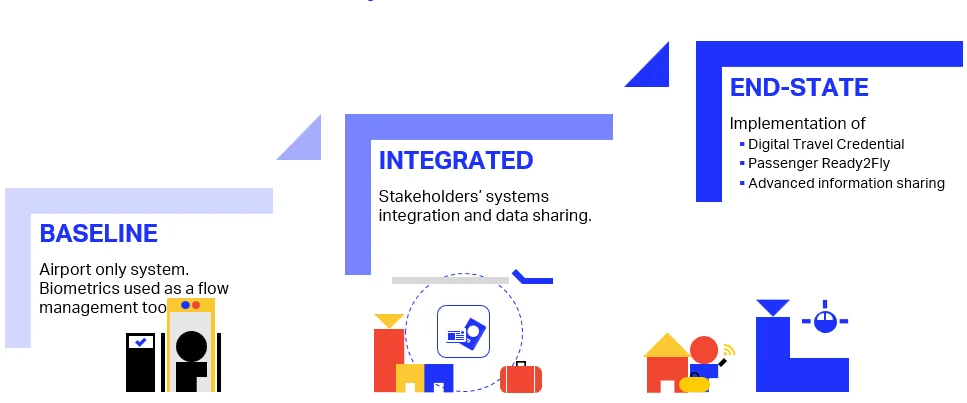The submit IATA study shows how the use of biometric technologies to manage passenger flow can streamline travel processes appeared first on TD (Travel Daily Media) Travel Daily Media.
The International Air Transport Association (IATA) launched a study displaying how substantial price financial savings, operational efficiencies, passenger expertise, and sustainability beneficial properties can be made by utilizing biometric digital ID know-how.
The stated know-how could also be utilised for managing the segregation of worldwide and home departing passengers at airports the place they’re at the moment separated by bodily boundaries.
Released on Thursday, sixth November, the Domestic and International Passenger Integration Programme (DIPIP) report is the end result of IATA’s collaboration with AtkinsRéalisan, an engineering companies and venture administration firm.
According to IATA senior vice-president for operations, security, and safety Nick Careen: “Regulatory requirements and technology limitations have meant that domestic and international departure passenger flows need to be physically separated at many airports. That’s no longer the case. Digital ID powered by biometrics can achieve the needed segregation without creating a physically separated flow with duplicated facilities which is inefficient and costly. The study shows that segregating passengers with digital ID will lead to a better travel experience for travelers, reduce costs for airports and airlines, and maintain security and border control requirements. It’s a compelling case for a much-needed modernisation.”
Likewise, AtkinsRéalisan aviation market director for the UK and Ireland Gareth Vest remarked: “The publication of this report is key in understanding how the concepts of digital identity and use of biometrics can play a significant role in improving passenger experience and creating substantial cost savings which will have benefits across the aviation sector. We have a strong working relationship with IATA and were delighted to work on this study, drawing on our own broad experience of integrating biometrics into the passenger journey.”
The advantages of biometrics
The study quantified the following advantages from segregating departing passengers with biometric enabled digital ID:
- Improved Passenger Experience: Removing bodily boundaries between home and worldwide departure flows will enhance passenger satisfaction with simplified journeys and shorter processing occasions. Minimum connection occasions, for instance, might be lowered by practically 20% with the efficiencies gained.
- Cost Savings: Shared services get rid of duplication in infrastructure, utilities, and staffing, lowering upkeep, working, and building prices for airports, airways, and floor handlers. Case research at main worldwide airports recognized up to an 11 p.c discount in airport employees prices, whereas a floor dealing with firm estimated a USD5.3M annual saving at one other main airport.
- More Efficient Use of Airport Infrastructure: Enabling departing passenger flows to use the identical bodily house permits airports to serve extra passengers inside present terminal footprints, optimizing use of house and the companies inside it.
- Sustainability Benefits: Consolidation reduces vitality use and construction-related emissions.
- Operational Flexibility: Shared services enable airports, airways, and floor handlers to higher manage fluctuating passenger volumes and deploy assets the place wanted. This is especially essential on condition that worldwide and home departures typically focus at completely different occasions throughout the day.
Careen defined: “The savings quickly add up. A medium-sized airport serving 10 million passengers annually could save up to $80 million of future capital expenditure and considerable annual operational savings through the removal of duplicate facilities and improved operational flexibility, while reducing its annual carbon footprint by 18,000 tonnes, or the equivalent of removing 4,000 cars from the road for a year. The case for change is clear. Managing departing passengers with digital ID instead of physical barriers delivers efficiency, emission reductions, and a smoother experience for travelers.”
Where to start
Implementation of DIPIP can start inside present regulatory frameworks.
Early phases, corresponding to shared terminal areas and biometric id verification, can proceed with out main regulatory adjustments, supplied shut coordination amongst airports, airways, and border authorities is maintained.
DIPIP outlines three phases of implementation: Baseline, Integrated, and End-State; these provide a sensible roadmap for adoption.
The End-State envisions a totally digital course of the place vacationers full id and travel checks remotely, making a seamless, safe travel expertise from house to gate.
According to Careen: “Collaboration is essential to unlocking the benefits of integrated passenger flows. Airports, airlines, and governments each have a role to play. By working together within existing frameworks and progressively modernizing them we can deliver seamless, secure, and efficient travel for passengers while maintaining the highest standards of safety and compliance.”
The submit IATA study shows how the use of biometric technologies to manage passenger flow can streamline travel processes appeared first on Travel Daily Media.
Source link




